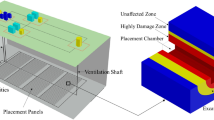Abstract
Using a three-layer model with a fractured central layer, and with a top layer and a bottom layer of the same thickness, we study the change of the critical fracture spacing to layer thickness ratio (i.e., the ratio at fracture saturation) as a function of the thickness of the top and bottom layers. Results show that, with increasing thickness of these layers, the critical spacing to layer thickness ratio decreases rapidly from infinity to a constant value, corresponding to that for very thick top and bottom layers. Also, we study the change of the critical spacing ratio as a function of the thickness of the top layer where the bottom layer is much thicker (5 times) than the fractured layer. In this case, the critical spacing to layer thickness ratio decreases rapidly from the value for edge fractures to the same constant value as the thickness of the top layer increases. These results imply that if the adjacent layers are thicker than 1.5 times the thickness of the fractured layer, the multilayer can be treated approximately as a system with infinitely thick top and bottom layers in terms of spacing at fracture saturation.
Similar content being viewed by others
REFERENCES
Aveston J., Cooper, G. A. and Kelly, A. (1971). The properties of fiber composites, IPC Sci. Technol. Press.
Bai T. and Pollard D. D. (in review). Spacing of opening-mode fractures in layered rocks: a new explanation. Journal of Structural Geology.
Bai, T., Pollard D. D. and Gao H. (in review). Spacing of edge fractures in layered materials. Internal Journal of Fracture.
Garrett K. W. and Bailey J. E. (1977). Multiple transverse fracture in 90° cross-ply laminates of a glass fibre-reinforced polyester. Journal of Materials Science 12, 157-168.
Hong A. P., Li Y. N. and Bazant P. (1997). Theory of crack spacing in concrete pavements. Journal of Engineering Mechanics 123, 267-275.
National Research Council. (1996). Rock Fractures and Fluid Flow: Contemporary Understanding and Applications, National Academy Press, Washington D.C., 551 p..
Parvizi A. and Bailey J. E. (1978). On multiple transverse cracking in glass fibre epoxy cross-ply laminate. Journal of Materials Science 13, 2131-2136.
Pollard D. D. and Aydin A. (1988). Progress in understanding jointing over the past century. Geological Society of America Bulletin 100, 1181-1204.
Price N. J. (1966). Fault and Joint Development in Brittle and Semi-Brittle Rocks, Oxford, Pergamon Press, 176 p..
Narr N. and Suppe J. (1991). Joint spacing in sedimentary rocks. Journal of Structural Geology 13, 1037-1048.
Thouless M. D., Olsson E. and Gupta A. (1992). Cracking of brittle films on elastic substrates. Acta Metallurgica Materialia 40, 1287-1292.
Wawrzynek P. A. and Ingraffea A. R. (1987). Interactive finite element analysis of fracture processes: An integrated approach. Theoretical and Applied Fracture Mechanics 8, 137-150.
Wu H. and Pollard D. D. (1995). An experimental study of the relationship between joint spacing and layer thickness. Journal of Structural Geology 17, 887-905.
Author information
Authors and Affiliations
Rights and permissions
About this article
Cite this article
Bai, T., Pollard, D.D. Spacing of Fractures in a Multilayer at Fracture Saturation. International Journal of Fracture 100, 23–28 (2000). https://doi.org/10.1023/A:1018748026019
Issue Date:
DOI: https://doi.org/10.1023/A:1018748026019




